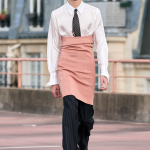
What happened to the ties?
No, they have not disappeared
July 1st, 2022
Last Sunday, the G7 leaders were photographed at the end of their summit meetings in Germany without wearing a tie. An accessory that has always - at least since the period of the Thirty Years' War (1618-1648) - been used in the most formal settings where the dresscode diktat rules unchallenged, the tie adheres to behavioral, aesthetic and social canons that are perhaps in crisis. So much so that the issue has come under the eye of fashion and costume critics who have decreed its death: "Some outfits have something wrong with them without a tie [...] they appear empty, like a night without stars. If you discard the tie, do so with intention, with a more modern cut suit, or remove even the classic white shirt replacing it with a polo shirt or turtleneck," said menswear writer Derek Guy.
i don’t understand people who celebrate the death of suits and ties like they’re rebelling against something. suits and ties have been dead for 30 years. if you want to rebel against upper class or hegemonic aesthetics, rebel against business casual
— derek guy (@dieworkwear) June 29, 2022
And if loungewear and leisurewear have considerably contributed to the crisis of formal dress, leading to a reinterpretation of uniforms in the narrow sense, the tie has seemed the ideal candidate for sacrifice. Sacrifice that, to see the SS23 collections presented during Milan and Paris Fashion Week, failed to take root on the moodboards of a slew of creative directors reluctant to give it up. Prada in primis: Miuccia and Raf Simons showed that contexts are still decisive in structuring an identity and that a tie, in its most classic and dark form, can even prove to be a winner. A choice also carried forward by Dolce & Gabbana which, in a revisiting of its early 2000s archive, gave a second life to an accessory seemingly far removed from low rise, tank tops and distressed denim. Same thing at MSGM where, alongside silhouettes punctuated by cropped shirts and ultra-short shorts, ties with prints or bold hues took shape.
The point, however, is that the ties that have recently appeared at the shows are quite far from the traditional idea of a tie. Rather than as an accessory tightly wrapped around the knot of the classic, ties have become symbols of a narrative tension that questions the meaning of formal wear, power dynamics, and masculinity in general. At Dries Van Noten, ties have been juxtaposed with corsets and pink lingerie, attempting to define a kind of genderless dandy uniform. And, perhaps the ones to be most uptight and subversive were those proposed by Thom Browne: frayed and paired with suits inspired by 1940s and 1950s couture, these ties scandalized an audience anchored in the traditional idea of formal dress. Not least because the audience the brands are targeting is no longer made up of a ruling class in need of everyday wear - the more classic menswear brands such as Brioni and Hermès did not bring ties to the runway - but extends to decidedly younger slices. It might be the case, imagining to envision a hypothetical scenario, that the tie might reappear in particularly trend-conscious circles or among young people seeking personal style.



























































